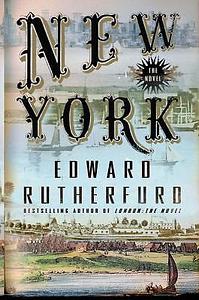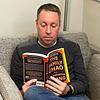Take a photo of a barcode or cover
The book just wasn't interesting. The characters were flat and most of the characters in the main family were not that likeable or relatable. And as a NYer, I had a hard time reading the 9/11 chapter since it still makes me panicky. I had wanted to read this book for a long time so I was very disappointed.
I learned more about US history in this book than my entire school career. I both laughed and cried throughout the book. It's long, but the stories are involved and touching. Highly recommended.
This book was intricately woven together to perfection. I was completely floored by the amount of labor that must have gone into a novel like this. Absolutely stunning book.
adventurous
relaxing
medium-paced
Plot or Character Driven:
A mix
Loveable characters:
Yes
Diverse cast of characters:
Yes
Flaws of characters a main focus:
No
informative
medium-paced
Plot or Character Driven:
A mix
Strong character development:
Complicated
Loveable characters:
Yes
Diverse cast of characters:
Yes
Flaws of characters a main focus:
No
Highly recommend reading before a visit to New York City. It really increased my appreciation of the city.
Well yes, the book was okay. But I am really not so interested in battle scenes and this book had a lot about the war of independence and the civil war in it. I could have done without all these "then they stormed up a hill while behind them the troops of the xxx cavallry were already ...." And so on.
Moreover, I found it increasingly unbelievalble that all the actors of the book and their descendents were to meet over and over again in different cicrumstances and the focus on white inmigrants and upper class was a little bit too much for me. Is it not possible to be a little bit more diverse? I can just suspect that there are not as many dates and history accounts on the other groups that lived in New York at any given time than there are about the white middle and upper class. Maybe thats why Rutherfurd concentrated on the rather well represented groups - historiographically speaking. But to my feelings it would have been much more interesting if he would have tried representing a broader perspective.
So, in the end, nice try, but I skipped the last hundred pages or so because I got bored.
Moreover, I found it increasingly unbelievalble that all the actors of the book and their descendents were to meet over and over again in different cicrumstances and the focus on white inmigrants and upper class was a little bit too much for me. Is it not possible to be a little bit more diverse? I can just suspect that there are not as many dates and history accounts on the other groups that lived in New York at any given time than there are about the white middle and upper class. Maybe thats why Rutherfurd concentrated on the rather well represented groups - historiographically speaking. But to my feelings it would have been much more interesting if he would have tried representing a broader perspective.
So, in the end, nice try, but I skipped the last hundred pages or so because I got bored.
Edward Rutherfurd's New York: The Novel delivers what it promises: A sprawling historical fiction that links generations of characters through significant events of the city's rich history. Beginning in the 1600s with the original Dutch settlers, we work our way through the Revolution, the Civil War, the Industrial Revolution, the Depression and into contemporary times. The cornerstone characters are the "old money" Master family, who trace their roots back to the original Dutch and English settlers on Manhattan island. Over the centuries, though, the story brings in tangential characters from all walks of life that range from slaves to Italian immigrants who land at Ellis Island to a middle-class Jewish family.
But much of the joy of this book is the little-known nuggets of historical fact, and how Rutherfurd relates these episodes to his characters. For instance, did you know that to quell the Panic of 1907, when widespread unscrupulousness in investing and banking practices nearly brought down the entire financial system, President Theordore Roosevelt handed $25 million to JP Morgan and basically said, "Save us"? And he did.
These bits of trivia (Wall Street is so-named because it at first literally was a wall that protected Dutch settlers from Indian attacks) are the take-aways from the book because looking back, it's tough to remember which Master character made a narrow escape from the 1863 New York Draft Riots or the name of the Italian immigrant who helped lay bricks for the Empire State Building as it went up during the Depression.
But that's okay, because this is an event-driven novel. For the most part, the characters are simply the vessels through which Rutherfurd allows his story of New York to flow. They're there to be representatives of their time and as a way to interface with the historical events. In a novel that spans 400 years, there's not time to give these characters a full emotional range.
That said, it's also worth mentioning that Rutherfurd's style can be a bit grating at times. Even during the longer sections that span a few hundred pages and several years with the same characters, Rutherfurd writes in page to page-and-a-half sections, which gives the narrative a bit of a choppy, start-and-stop feeling. James Michener, who invented this historically hefty genre, writes better than Rutherfurd does, in my view.
The book winds up telling the stories of Gorham Master, a rich Wall Street banker, and his wife Maggie O'Donnell, a lawyer and descendant of the Masters' 19th century poor servants from Five Points. Though it takes more than 800 pages to get to the one part of New York's story that will really resonate with readers, Rutherfurd does a very commendable job of fitting his characters into a dramatic and harrowing 9/11 narrative. The wait is worth it for this part.
Overall, if you're a fan of the Michener-esque long historical novel, you'll probably enjoy this. I'd give it 3.9 out of 5 stars (yes, just slightly below four stars). I learned a lot from this book and, for the most part, enjoyed the three weeks I spent with it. It also was a lot of fun to read this book before, during and after trip to New York — and then visiting Battery Park, Wall Street, Trinity Church, the Empire State Building and other historical landmarks, all which figure prominently in the story. So if you have similar plans, that'll probably bump up your enjoyment of the book as well.
But much of the joy of this book is the little-known nuggets of historical fact, and how Rutherfurd relates these episodes to his characters. For instance, did you know that to quell the Panic of 1907, when widespread unscrupulousness in investing and banking practices nearly brought down the entire financial system, President Theordore Roosevelt handed $25 million to JP Morgan and basically said, "Save us"? And he did.
These bits of trivia (Wall Street is so-named because it at first literally was a wall that protected Dutch settlers from Indian attacks) are the take-aways from the book because looking back, it's tough to remember which Master character made a narrow escape from the 1863 New York Draft Riots or the name of the Italian immigrant who helped lay bricks for the Empire State Building as it went up during the Depression.
But that's okay, because this is an event-driven novel. For the most part, the characters are simply the vessels through which Rutherfurd allows his story of New York to flow. They're there to be representatives of their time and as a way to interface with the historical events. In a novel that spans 400 years, there's not time to give these characters a full emotional range.
That said, it's also worth mentioning that Rutherfurd's style can be a bit grating at times. Even during the longer sections that span a few hundred pages and several years with the same characters, Rutherfurd writes in page to page-and-a-half sections, which gives the narrative a bit of a choppy, start-and-stop feeling. James Michener, who invented this historically hefty genre, writes better than Rutherfurd does, in my view.
The book winds up telling the stories of Gorham Master, a rich Wall Street banker, and his wife Maggie O'Donnell, a lawyer and descendant of the Masters' 19th century poor servants from Five Points. Though it takes more than 800 pages to get to the one part of New York's story that will really resonate with readers, Rutherfurd does a very commendable job of fitting his characters into a dramatic and harrowing 9/11 narrative. The wait is worth it for this part.
Overall, if you're a fan of the Michener-esque long historical novel, you'll probably enjoy this. I'd give it 3.9 out of 5 stars (yes, just slightly below four stars). I learned a lot from this book and, for the most part, enjoyed the three weeks I spent with it. It also was a lot of fun to read this book before, during and after trip to New York — and then visiting Battery Park, Wall Street, Trinity Church, the Empire State Building and other historical landmarks, all which figure prominently in the story. So if you have similar plans, that'll probably bump up your enjoyment of the book as well.
This epic adventure takes you from the Dutch settlers to modern day (circa 2009) of New York history. Bringing history to life with narrative fiction this engrossing is a challenge Rutherford meets splendidly. I was engaged in each generation as they grew and was absorbed in how all the vastly differing families were interwoven through time. A brilliant novel and worth a read.
I started reading this before a trip to New York City. The characters are flat and interchangeable. The plots are expected. But I enjoyed the history of the city. I didn't mind wading through pages if it helped me understand one of the world's biggest and best cities.
I was super into this book until about the last 200 pages. Mainly, the history of New York and the way it was woven into the stories of these characters was excellent and heartwarming. As I got closer to present day, however, Rutherford started to skip decades and gloss over major periods in history. The 30s and 40s are completely omitted and the 60s and 70s are summed up in a few paragraphs. Additionally, the main characters of focus are of the original Dutch/British family and later the German and Irish. The other immigrant communities that make New York City the diverse city it is today are barely mentioned or serve in support roles. All the characters are broadly painted stereotypes that emerge triumphant “rags to riches” success stories, perpetuating the conservative American “bootstraps” narrative. While the early history is interesting, I think I was disappointed to learn that Rutherford is an Englishman...explains the lengthy focus on the early history. Would love to read a version of this book by a more appropriate storyteller.




